First, a simple test if you are not sure what kind of paint it is, then we show how to remove paint from plastic: both latex and oil. You probably have what you need at home now.
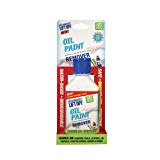 The go-to product (something we should all have around the house) is Motsenbocker’s for latex paint and for oil paints (both shown). Mr. Motsenbocker, is there anything you can’t do? How to know what paint you have it key.
The go-to product (something we should all have around the house) is Motsenbocker’s for latex paint and for oil paints (both shown). Mr. Motsenbocker, is there anything you can’t do? How to know what paint you have it key.
Is your paint latex or oil-based? Test it:
Latex will become gooey when exposed to certain solvents.* Acetone is the best way to tell if dried paint is latex (most nail polish removers have acetone), but rubbing alcohol will also dissolve latex, just more slowly. Video of me doing this test is at the very bottom.
How to Remove Paint from Plastic (Without Damage):
- Put on some gloves.
- Rub acetone or alcohol on the paint in a test spot and keep it wet for a few minutes. Don’t get acetone on the plastic (it may melt).
- Not gumming up? It’s oil.
- Gummy? Latex.
- The video at the very bottom shows what it looks like.
Latex?
If latex, go to the post just about removing latex paint: you are the lucky ones.
Oil-based (alkyd)?
1. Is it still wet? Keep it wet! Apply the paint’s known solvent right away if you can. Not sure about the solvent? Start with paint thinner (mineral spirits). Lighter fluid and gasoline will work too.
- Wear gloves!
- As you wipe, the thin residue will dry fast: don’t let it: keep it wet with paint thinner or even cooking oil until you can get the full clean-up going.
- Don’t use a cloth with much dye—it leaves a mark!). Other solvents listed below.
- Wash hands very well if it touched your skin:
- Don’t be a cowboy, John McClane…Yippee-Kie-Yay it slowly seeps into your blood.
2. Has it dried up? Let’s start with what we have around the house, then we’ll look at some solvents and paint removers (and stock up for next time). That old paint remover is now illegal for good reason. Read the Washington Post about new law from the EPA, or you can it on the EPA’s website.
• Always do a test spot for each method to see if the solvent harms the plastic (or any surface) underneath.
- Use a tool to scrape off what you can: choose a tool that won’t scratch the substrate.
- Tru cooking oils, motor oils, WD-40, etc, — these work best if the paint has only recently dried. It will just soften paint for easier removal.
- This eco-safe stripper claims it can remove 30 coats of paint at once: we have used strippers like this and it works, but slowly. Keep it thick and wet to keep it working.
- Motsenbockers’ Lift off for oil-based paints linked above is an old standard.
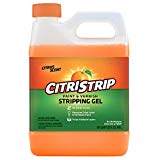
- Citrus based gel paint removers (shown here) do work, but slower (and safer).
- Shocker: eucalyptus oil worked! We add this to laundry to kill dust mites etc. Oh, how we love this stuff. Me-love-you-long-time. Pricey.
〉〉 From here down, wear gloves, eye protection, & respirator! The complex world of respirators is simplified here. - Paint thinner — let soak, then remove with a tool. We prefer odorless thinner, ah.
- Alcohol— will not work for oil-based paints, but will for latex.
- Nail polish remover, linked above. It’s just acetone— let soak, then remove with a tool. This is likely to damage the plastic.
- Acetone — let soak, then remove with a tool (use the link in #9). This will damage most kinds of plastic.
- Lacquer thinner: very flammable! — let soak then remove with a tool. Warning: this can melt plastics.
- Old-fashioned paint remover: nasty but effective. I’d not use this unless the above methods fail.
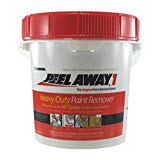
- Heat Gun — Go ahead, make my day. Fun to use? Sure but…keep it moving to avoid melting the plastic. Really made for removing paint from metal, but this is your .45 Magnum, the most powerful handgun in the world, Clint.
We have listed scrapers and all the basic painting tools in one place.
SOLVENTS: Most of these are toxic so you will need to wash your hands well if you touch it. Don’t delay.
Important Safety Warning: How to remove paint from plastic if the paint contains Lead
Before removing old paint, make sure it contains no lead. Did you hear that it causes irreversible damage to the brain, liver, and kidney? With this kit, you can take 5 samples, send them into the EPA approved lab and the cost of the lab is included in the purchase. I’ve looked at other kits that have hidden fees.
Removing lead paint? Wear the respirator on this page with the purple, circular filter: the 3M 2097, Organic Vapor Relief. Take that lead and transmute it into gold: pays for itself.
How to remove paint from plastic or from anything, if any lead paint is present: wear a good respirator mask: read about my respirator: it’s cheap insurance. Also…
Read from the EPA about what professionals are required in “abatement projects in pre-1978 target housing and child-occupied facilities to be certified and follow specific work practices.”
I ruined a collector’s item once because I guessed at how to remove paint from plastic: it turned a G.I. Joe bald. I hope this all helps.
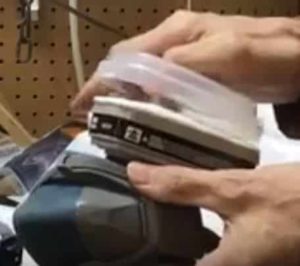
Finally, done? Wash skin over and over with lots of soap to get any chemicals off.
Did we forget something? Let us know in the comments if you have some concerns or insight as to how to remove paint from plastic or how to remove paint from anything of any kind. Thanks!
How to Touch-Up Paint In 4 Steps (mostly deals with walls, but gives some tips)
How to Remove Spray Paint (From All Kinds of Surfaces)
How to Get Spray Paint Off Skin (with Home Remedy)
How to Remove Latex Paint: Dry or Wet (Painter’s Rag Trick)
The first of 2 videos below show the tests we ran.
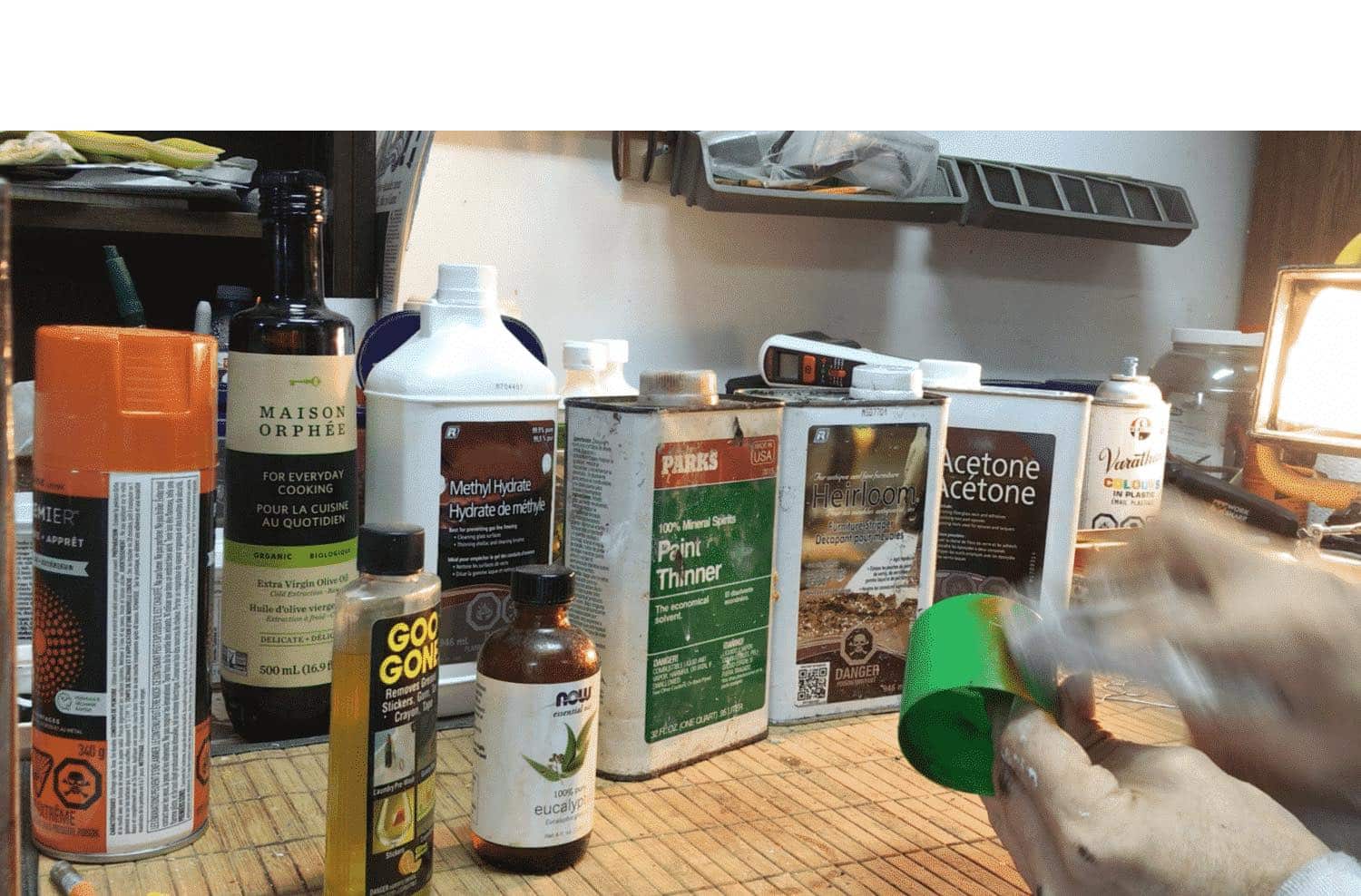
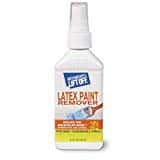
Hello, long shot but I would like to ask if you have a method for removing well dried oil-based AND water-based paint from an acrylic surface, specifically a tub. I don’t want to damage the surface further and I’m very concerned about scratching. Any help would be greatly appreciated.
Should not be hard: paint remover. Not the safe citrus stuff…get the toxic stuff. Read above.
Hi Brad,
How do I know if the spray paint I am trying to remove is oil based or acrylic based without damaging or risking damage to the plastic?
I found a list of ingredients but the list makes me feel lost:
Ingredient name
Propane
Hexane
2-Methylpentane
Stoddard Solvent
Polyester
Light Aliphatic
Hydrocarbon Solvent
3-Methylpentane 2,
3-Dimethylbutane
Cyclohexane
2,2-Dimethylbutane
Nonane 1,2,
4-Trimethylbenzene
Cyclopentane
I don’t see oil or acrylic on the list!
It’s never clear what they put in that stuff. The way to test is to take some dry paint and try the various solvents as i explained in the article. It’s what I do. My guess is acetone is the thing but start with oil, then paint thinner etc. Good luck
My neighbour has spray pained his side of the fence,and unfortunately some of it has gone onto the plastic surrounds of my double glazing. It is only small drops but a lot of them. He says the paint was water based, but will not wash off. Any ideas please
Yes, just go as I wrote in this post: start low and go high. Olive oil. No? Paint thinner? No? Paint remvover? no? still? Lacquer thinner is the most toxic and harshest and will damage plastic. Elbow grease on all of the above helps. Best of luck for this.
After removing the old paint than I primed the plastic with zinnzer bins and two coats of oil how much should I charge
Charge? What do you mean?
Good morning brad I ran in to a little problem I had to remove the old paint from the plastic trim around the windows on these metal doors after getting the old paint of I primed with Bins than two coats of oil they look great I charged the guy $70 bucks a door plus sanded the rust off the metal header or Lenal above the door same process now the home owner is saying that’s two much I just want your opioin ty
I see. Well, depending on where you live.. I never lift a brush for less than $200. For some small jobs I’d tell the customer to find other things for me to do because my minimum is 200.
Plus what you are describing is nasty. I’d charge more than 70. If he’s happy he should be grateful he did not call me!
Good luck
b
Hi Brad,
I recently moved into my apartment and found that my thermostat control was completely painted over. It’s permanently on high heat and I’m now sure how to remove it without damaging the older thermostat.
This is difficult for me not being able to see it. If you can send a photo that would help. But if you can remove it, including the 2 wires (it’s usually low voltage, like a doorbell), you could soak it and the latex paint would soften and you could remove with your fingernail or plastic scraping device. The dry fast with a blow-dyer or in the sun. Just guessing here.
Brad
So my daughter painted a Fatmax toolbox with acrylic paints then used a spray sealant to keep it from peeling. How do I safely remove this so I don’t damage the toolbox. The end goal is to spray paint the entire toolbox red.
Well, first of all give that girl a time out!
But seriously, if you can use force to crack the paint and varnish, you can peel off most.
If it’s bonded and won’t come off, because the box is plastic, there’s not a lot you can do, sorry to say.
Just like this post says, start with low toxicity and then go more and more intense until some solvent works.
Acetone will work, but will also damage the plastic. But if you don’t care give it a go.
Do that outside or wear a respirator. Good luck
So, I used Rust-Oleum American Accents 2X Ultra Cover Ultra Matte for a model kit and the first coating, for various reasons needs to be stripped on some of the parts. Might be awhile until I can buy anything so expect a drying time of at least few days, if not more. What do I use? mineral spirits I saw for some rustoleum, but I keep seeing other stuff can be used so I don’t know what would be the best.
A quick look at the tech data sheet suggests:
CLEAN-UP
When finished spraying, wipe off tip before storing. Clean
up wet paint with xylene or mineral spirits.
So I think that means paint thinner, or the above. You can try olive oil first as it cannot harm the model.
But the paint thinner could, so do some testing as you increase the various solvents until you find one that works.
Hope this helps.
b
I bought a Rubbermaid 150 gallon trough (@ a rummage) to use as a pond/water garden. They spray painted the inside white. It’s flaking off and I want to remove it all to keep the potential fish safe. What’s the best method?
Gosh, I have never heard of this. I’d beat it up with a hammer and what sticks after that, I’d go with the list of things I wrote above. Always start with the least toxic. Oil, then various toxins.
Good luck!
Brad, thank you for the quick response! I will read through your article again.
Brad, I have a club car golf cart with a plastic type of roof maybe polymer. The top side has been painted with a 2 stage base coat & clear coat . I want to remove it.
Secondly the underneath has been painted with a single stage paint. 50% of the paint on both surfaces has released it self just from the sun exposure. How do I remove the remainder of the paint.
I’d start with the least toxic, least invasive solutions listed on this page above.
Try to get some chips off and test them directly with various soutions.
Hard to say what that paint is, but in any case, when you find something that dissolves it, test carefully if it de-glosses or melts the roofing.
Do all you can by muscle!
Good luck!
What would you use to remove paint from a wafer light without damaging or affecting long term? Will the paint remover affect the coloring long term? There is paint on wafer trim and light surface it self.
Hi. Just as this post above reports, that’s all I can offer. Just start with the least invasive, like oil, then citrus etc. Do tests in spots to see the effect.
If all goes wrong you can paint what you damage.
Good luck, sorry I cannot be of more help without doing the testing myself.
B
Hi Brad
I have plastic toy that was made in 2003 from ABS.
I recently purchased it but noticed the previous owner applied a coat of spraypaint (not sure what kind but my guesses are it was a Tamiya acrylic spray paint as they were popular for these toys).
I am trying to remove this layer of paint by the previous owner (it’s a turquoise colour) back to the original manufactured plastic which was a navy colour. I want to remove that turquoise spray paint coat without damaging the original plastic and without affecting the manufacture paint colour.
Can you recommend a solution to achieve this please?
I am based in UK and it seems everyone has different ideas and half the products are not available in UK. Also I dont want to waste money on products that do not work lol.
Hi. I can only repeat what I wrote above.
STart with oils, houseold, olive the slowly move to more destructive solutions.
Good luck
B
Question, recently purchased 2 composite wood patio doors in white we wanted brown and not able to get selected door choice, in error we painted both brown using oil based paint and they look terrible. have since decided we would like to strip the paint back to white as original. What is suggested to use with out ruining the finish ?
Thank you
Eek! Use ‘old fashioned’ paint stripper on this page above but… warning it’s a long haul to remove the paint. Here’s an idea. One coat of Prime Lock after a light sanding, then 2 coats of white. You will have 5 coats and it will look a little globby, but sand between coats and keep your coats thin.
Read about Prime Lock here.
Best of luck!
PS, you can always call a pro for advice…they give free estimates and we know that often people just want the info to DIY. But sometimes we get the work too!
B
You could strip with a paint stripper, probably not a citrus one as they are slow and weak but safe. The toxic ones are terrible and great !But I would prime with PRIME LOCK from Ben Moore after sanding the entire thing.Then sand the primer, then 2 coats of your paint, with a light sand in between coats.You need 2 more no matter which way you go and this way instead of stripping you just are doing 3 coats not 2.But the final door will be thick with paint and not look like a factory spray job. If you want that, strip it and put thin coats on or spray.I just published two articles on a sprayer that would be perfect for that. Anyway, best of luck!
Brad
HVLP sprayers
Handheld airless.
Just use Easy-Off. It doesn’t harm plastic.
I guess it depends on the type of paint.
Thanks
It contians Sodium Hydroixide….scary stuff!!!!
Hi Brad,
I have a rental home and the tenant painted over the oil based painted kitchen cabinets with latex. I am having some success getting the paint off using Goof Off, but I wondered if there was a better product to try? Goal is to remove the latex and not damage the oil base under it. I don’t want to have to sand down the entire kitchen and repaint if I can avoid it.
Ooo. Too bad. Even when I was asked to do quick bad work like this (when someone was selling or renting), I talked the customer out of it. It’s just wrong to put latex over oil without proper prep. And today, there are great primers for bonding that did not exist a decade ago.
I’m wondering why you want to protect the oil-based paint underneath. What did that paint ever do for you? ha ha. Really though, if you want to get through this quickly, use a real paint remover and oil paint be damned!
Then you can do a final LIGHT sanding and priming and use any paint you like.
But in any case, you are doing the job right: you have to get that latex off.
But I’d step up to the citrIs remover (shown above) and if that is too slow, the go to nuclear war with the old-fashioned toxic paint remover.
I added the nasty paint remover above: right under the Citris Strip.
How do i remove latex paint that was spilled in a plastic bathtub and left to dry. Its been there about 6 months?
Ray
Use a plastic knife to get all you can, then use a paint remover. If the plastic knife is too flimsy, try a metal putty knife… but this may scratch the tub.
Put any paint remover you try on and lay plastic over the goop so it won’t dry out. After several hours, the paint may just come off easily.
Good luck!
Great post, thanks
Same problem as Mr Fowler.I painted door molding for a nissan.company said the material was printable,it has been 10 days with it sitting in front of a fan in the spare room.sticky and tacky.used rust-klein x2 flat black.can I remove it and what should I use to repaint. Sorry spell check changed some words hope you can figure out what I meant.
Yes, wipe, and use solutions, probably paint thinner/mineral spirits…whatever it takes. Sand the surface and start over. That is in the best case.
My guess is that it did not dry because the paint is bad: mixed badly. Look online and see if there are any others? Or perhaps you mean that it dried, but did not bond. That is more likely I think. Plastic is not known for accepting paint, but if you sand or use a de-glosser, and then the right primer (I’d suggest STIX), you can paint.
Whatever you do, apply in test spots, wait to see if there is bonding. If yes, have at it.
Book muck.
ha ha…good luck
b
Used Rustoleum x2 bonds to plastic (Supposedly ) well it did that most of the plastic in my daughters car by not to the door panels which I think mite have a thin vinyl coating. But anyway way it won’t dry it’s sticky and tacky. I need to get this crap off. How Thank u
Dios Mio. It’s a mess but you’ll need to use a plastic scraper or something that won’t harm the surface and get all you can…go little by little.
Then use the solvent for the X2 which I read is mineral spirits.
But my question is why that did not dry. Did you apply very thick coat? Multiple thin coats is recommended.
Can you send a pic or video of the goop? Good luck in any case.
B
How about getting paint off a carbon fibre composite bicycle part?
Hi. What kind of paint? Do the test with acetone: if it gets gooey, it’s latex. Use water and slowly work it. If it does not get gooey, it’s oil-based or some other base. Try paint thinner, oils, etc. Let me know if not working.
b
I can not say thank you enough for this post. TOTALLY SAVED ME. I got metal primer on a bubba keg I was commissioned to do and I thought I was gonna have to rebuy it … I had already tried acetone… scrubbing everything … but sure enough little bit of mineral spirits fixed her right up. Thank you thank you thank you!!!
Great!